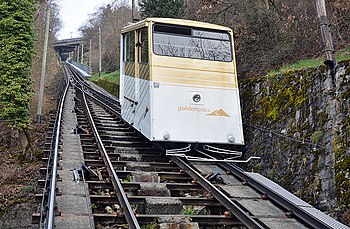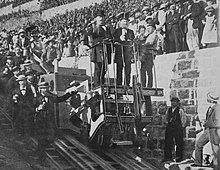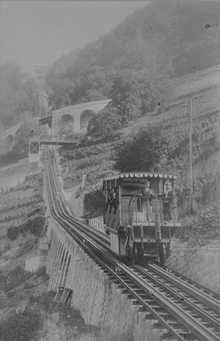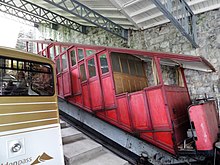Territet – Glion funicular
| Territet – Glion funicular | |||||||||||||||||||||||||||||||||||||||||||||||||
|---|---|---|---|---|---|---|---|---|---|---|---|---|---|---|---|---|---|---|---|---|---|---|---|---|---|---|---|---|---|---|---|---|---|---|---|---|---|---|---|---|---|---|---|---|---|---|---|---|---|
| Timetable field : | 2054 | ||||||||||||||||||||||||||||||||||||||||||||||||
| Route length: | 0.64 km | ||||||||||||||||||||||||||||||||||||||||||||||||
| Gauge : | 1000 mm ( meter gauge ) | ||||||||||||||||||||||||||||||||||||||||||||||||
| Maximum slope : | 570 ‰ | ||||||||||||||||||||||||||||||||||||||||||||||||
| Rack system : |
until 1974: Riggenbach brake rack system |
||||||||||||||||||||||||||||||||||||||||||||||||
| Territet – Glion | |||||||||||||||||||||||||||||||||||||||||||||||||
|
|||||||||||||||||||||||||||||||||||||||||||||||||
The Funicular Territet – Glion , French Chemin de fer funiculaire Territet – Glion , abbreviated TG , is a funicular on Lake Geneva in the canton of Vaud . It connects the towns of Territet and Glion , which both belong to the municipality of Montreux . The railway is operated by Transports Montreux-Vevey-Riviera (MVR) and advertised in the tourism business by the Montreux-Berner Oberland-Bahn (MOB) under its brand name Goldenpass .
history
The Territet – Glion funicular, which opened on August 20, 1883, was the second water ballast lift in Switzerland after the Giessbachbahn . Unlike the Giessbachbahn, Niklaus Riggenbach opted for a track system with two separate tracks.
When it opened, the cable car was the second-steepest funicular in the world after the Funicolare Vesuviana on Mount Vesuvius . Shortly before commissioning, Riggenbach demonstrated the effectiveness of the wagons' brakes. He took a seat in one of the cars at the mountain station and had the pull rope cut. He drove all the way to the valley station and regulated the speed simply by actuating the spindle brake .
The profile of the system from 1883 was unfavorable because it had a steep slope in the lower area so that the valley station came as close as possible to the Territet train station on the Simplon route . The bottom 91 m showed a slope of 300 ‰ , the top 345 m a slope of 570 ‰ . As a result, the haul rope lifted off the track when a car approached the valley station. Furthermore, the wagon going downhill had to take an excessive amount of water with it in order to be able to pull the wagon going uphill. In order to prevent the rope from being lifted off, hold-down rollers were attached below the avoidance point, which were automatically swiveled in by the wagon driving downhill after the wagon had passed and swiveled out again when driving uphill.
Nevertheless, the kink in the profile did not prove itself, because the cars had to drive the lowest part of the route with a lot of momentum, which sometimes triggered the safety brake. The profile of the line was therefore corrected from November 1890 to April 1891 so that it corresponded to a parabola , no longer had a broken slope and the hold-down rollers could be dispensed with. At the same time, the route was shortened by 42 m, which is why the path from the valley station to the point where the cars boarded is unusually long. In 1893, new, larger wagons came to the railroad that carried 50 instead of 30 passengers.
In 1892 the Glion – Rochers-de-Naye cogwheel railway started operations, the valley station of the cogwheel railway was at the mountain station of the cable car, so that it served as a feeder for the cogwheel railway. It was not until 1909 that the rack railway was extended to Montreux, so that the cable car no longer served as a feeder for the rack railway.
On September 28, 1974, the water weight cable car operated for the last time. After that, the plant was converted to electrical operation, whereby the only in Switzerland funicular Cossonay and the funicular Neuveville-Saint-Pierre in Freiburg as a water ballast tracks were available - Cossonay was changed in 1982, the cable car in Freiburg is still moving today with water ballast and is in this form will be preserved as a national cultural asset. A carriage from the old Territet – Glion railway has been preserved in the valley station.
In 2009 a further renovation was carried out, whereby the intermediate stop Collonge is now served. The cars received emergency exits and a new coat of paint in the colors of the Goldenpass group.
technology
Plant from 1883
The route runs in a straight line. Each car runs on its own track, which had a track center distance of 1138 mm to the neighboring track, so that the two inner rails including the rail heads were only 138 mm apart. The tracks were widened to a turnout in the middle of the route so that the cars could cross. This arrangement cost more than that of the Giessbachbahn, where an Abt switch was used, but it was felt to be safer because the pull rope did not cross the rails and the complicated switch construction was not necessary.
The train was driven with water weight . The water that was filled into the tank of the car in the mountain station made it heavier than the car in the valley station, so that the cable car started moving. The speed had to be regulated by pressing the brake of the car on the descent, as the train tended to get faster during the journey because the weight of the increasing rope on the side of the car going downhill provided additional drive. Brakes were used for the service and emergency brakes, which acted on cogwheels that meshed with a Riggenbach rack . On the two-axle wagons, the cogwheel for the cable breakage brake was attached on the mountain side, and a spindle brake also acted on the platforms on the mountain side of the wagons. The spindle brake on the valley side of the car worked via a brake shaft on the gear on the valley side. It also served as a service brake and was operated by the driver driving downhill.
In contrast to most of the funiculars, which gave the two cars the numbers 1 and 2, the Territet – Glion cable car used the designations E for Est 'east' and O for Ouest 'west' .
Plant from 1975
After the renovation, the cable car started operating again in June 1975. The system was converted to an electric drive. At the same time, the track system was rebuilt so that there is only one common track for both cars, which has an Abt switch in the middle of the route so that the cars can cross. The wagons received feeler bars to detect obstacles on the road.
Technical specifications
| Tact | 10-20 min. |
| Operating modes | Automatically |
| Gauge | 1000 mm |
| Wheelset | Asymmetrical with double flange wheel and roller wheel |
| length | 640 m |
| Height difference | 301 m |
| Medium slope | 54% |
| Soft | Abbot's switch |
| Travel time | 4 min |
literature
- Alphonse Vautier: Notice on the chemin de fer funiculaire de Territet à Glion . In: Bulletin de la Société vaudoise des ingénieurs et des architectes . 1885, doi : 10.5169 / SEALS-12039 (French).
Web links
- The Territet – Glion cable car. Montreux Oberland Bernois (MOB)(French, operator's site).
- 1820.01 Territet - Glion. In: standseilbahnen.ch. Markus Seitz, 2019.
- Radio Télévision Suisse: Le Territet - Glion. In: notrehistoire.ch. February 7, 1967 .
Individual evidence
- ↑ Hans G. Wägli: track profile Switzerland in 1980 . General Secretariat SBB, p. 71.
- ↑ Dienststellen_full.csv. In: Open data platform for public transport in Switzerland. December 22, 2019 (height of the stops).
- ↑ OpenStreetMap contributors: Open Street Map. Retrieved December 24, 2019 .
- ↑ a b Alphonse Vautier, Dispositions générales, p. 22, column links
- ↑ a b Alphonse Vautier, Dispositions générales, p. 21
- ^ Funicular Territet-Glion. In: notrehistoire.ch. January 17, 2019, accessed December 25, 2019 (French).
- ↑ standseilbahnen.ch
- ^ Hefti, Walter: Rail cable cars all over the world: inclined cable levels, funiculars, cable cars . Birkhäuser, Basel 1975, ISBN 3-7643-0726-9 , p. 238 .
- ↑ Fig . 23 . In: Railway amateur . No. 3 , 1975, p. 131 .
- ↑ Olivier Tanner: Transports Montreux-Vevey-Riviera. In: Eisenbahn-Schweiz.ch. Accessed December 26, 2019 (German).
- ↑ Alphonse Vautier, panel Détail des Freins
- ^ Hans Waldburger: The last cable cars with water weight drive . In: Railway amateur . No. 10 , 1979, p. 595 .






